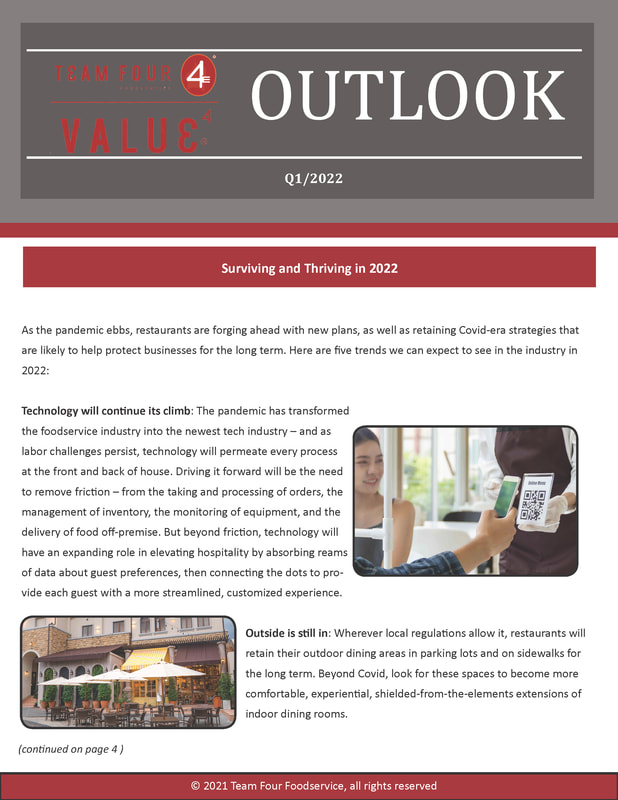 Looking back at the past year can reveal some clues as to what we can expect in the year ahead. For many restaurants last year, food became more creative again as restaurants looked for ways to provide fresh experiences to guests while sticking to small core menus and tight budgets. One approach restaurants used accomplished this – and are likely to use again this year – is offering a rapid progression of limited-time offers. Technomic research found that in October alone, restaurants introduced more than 2,200 new menu items, of which a whopping 93 percent were limited-time offers. These items are vehicles that enable restaurants to inject something new into the menu on a frequent basis. Restaurant Business reported that some restaurants have been offering limited-time menu items with shifting seasonal ingredients, variations on core menu items, and more innovative items that allow chefs to test potential new offerings or show off a skill that might not have a chance to shine on a core menu. As you look ahead to the rest of the year, are there opportunities to more frequently change up your offerings with items that can refresh the experience you offer guests?  Serving an exciting, on-trend menu is a key component of a worthwhile restaurant experience. So what taste treats belong on your menu this year? The National Restaurant Association surveyed more than 1,500 culinary professionals and narrowed their responses down to 10 trends for 2024. One key theme is global flavor – in soups and stews, including Birria, Chicken Tom Kha, Laksa, Salmorejo and Upscale Ramen; as well as in chicken wings and barbecue. Meat is still on the menu, but it’s higher-end options like Wagyu beef that are trending. Culinary professionals are also exploring new ways of preparing in-demand ingredients – such as grilling or cooking cheeses like Provoleta, Queso Fundido, Raclette, Halloumi and Juustoleipa; offering stuffed vegetables including Chiles en Nogada, stuffed peppers and stuffed cabbage rolls; and adding some sweetness to the breakfast menu with hot honey breakfast sandwiches. Regional flavors are still in demand and operators will continue to streamline their menus in an effort to operate as leanly as possible. To get the word out about their menus and promotions, expect to see more operators expanding their use of social media – and TikTok in particular – to boost engagement in creative ways. Could any of these ideas support your plans for the year?  Is there room to step up your mocktail menu? Nonalcoholic beverages have been on the rise in restaurants in recent months and will likely continue to draw interest in the New Year as consumers place renewed focus on health and nutrition. According to research from DataM, the global market for nonalcoholic beverages is expected to grow 6.5 percent annually through 2030. All of this is good news for restaurants because the cost of nonalcoholic drinks tends to be lower than that of alcoholic drinks, yet guests are generally willing to pay similar prices for them. An interesting beverage can help a person feel more social when out with a group, so there is opportunity to promote your offerings to larger gatherings. Consider mixing in on-trend fruit flavors, pairing unfamiliar flavors or functional ingredients with more familiar ones, as well as creating options that mimic the fun and flavor of alcoholic drinks like mojitos and margaritas but omit the alcohol.  One way restaurants can make the dining experience feel more special to guests is by allowing customization – enabling guests to order a dish the way they want it. But at a time when restaurants need to operate as efficiently as possible and may lack experienced staff, customization can be a strain. According to Restaurant Dive, Starbucks has experienced labor challenges with complicated drink orders in the past, and its recent introduction of four holiday-themed cold-foam flavors aimed at driving demand beyond the holiday season may compound that issue. It’s something to consider if you are weighing options to increase the customizability of your menu. Even if those efforts seem small, they need to strike the right balance with the labor you have available to carry them out. At your restaurant, have you maxed out your tech-driven efforts to make your experience feel more personal? Having automations set up to send a guest a coupon for a free dessert on their birthday can feel personal, as can sending targeted, preference-driven promotions to guests through your loyalty program.  Times are changing. While Thanksgiving was once a quintessential home-based holiday, many more consumers stepped out to restaurants for their meal this year. Restaurant Business found that the percentage of consumers who planned to eat their Thanksgiving meal in a restaurant this year was double what it was last year. So project this forward to the holidays to come. As your restaurant plans for the festive season, experiences will continue to be important – and there may be an opportunity for you to provide high-value dining experiences for your guests. Restaurant bookings are showing that there is an appetite for it. Plus, at a time when convenience is so important to consumers, helping them avoid spending a day in the kitchen preparing food for holiday meals could hold strong appeal.  If you have been feeling your dayparts dissolve a bit in recent years, you’re not alone. Consumers are craving their favorite foods at any time of day, which creates both challenge and opportunity for restaurant operators. A number of large restaurant brands have been trying to drive sales outside of their normal dayparts. Restaurant Dive reports that Pizza Hut is making a push for late-night snackers, Denny’s is adding a burrito virtual brand to boost sales during off hours, Wendy’s is launching efforts to draw both late-night and breakfast traffic, and Marco’s Pizza launched a handheld pizza designed for eating on the go. Taking a look at your guest traffic, do you see opportunities to encourage more sales at hours that fall outside of traditional meal times?  As the gap between restaurant and grocery store prices has widened recently, the grocery stores that have managed to create café- and food hall-style spaces within their walls are drawing customers who crave restaurant-quality meals, but at a lower price point. If these dining options are becoming more worthy competitors for your restaurant, focus on providing what the grocery stores don’t. That could be your attentive customer service, customized promotions, the memorable experience you provide in your dining room and at events, or prompt delivery. Alternatively, you might also take a page from your neighborhood grocery store’s playbook and provide elevated retail items that allow your guests to easily prepare and enjoy aspects of your menu at home.  As turbulent as the past few years have been for the restaurant industry, they have also sparked a positive transformation – in how restaurants are managed and operated, as well as in the design of restaurant concepts themselves. That is creating opportunities where they may not have been as visible before. Case in point: Food halls, once largely urban destinations, have been moving out to the suburbs, as well as onto college campuses. There are currently about 360 food halls in the U.S., up from 220 in 2019, according to research from the brokerage Cushman & Wakefield. That number is due to jump again in 2024, with another 124 food halls under development across the country, and is expected to climb even higher later this decade. The growth is happening in regions as diverse as Nevada, Alabama and North Dakota. The food halls are collections of chef-driven concepts that are providing opportunities for newer chefs to test their ideas in spaces available at a lower price point than would be possible in a city. The most successful concepts are tapping into consumers’ desire to have an entertaining experience around food. They have a captive audience in college students and in suburban hybrid workers who are motivated to try new foods and eager to connect with coworkers and friends.  As you weave more plant-based ingredients into your menu and guests continue to seek health-boosting ingredients, floral flavors can help. Flavors such as jasmine, rose, lavender and hibiscus have been on the rise in recent years and continue to spread – particularly on the beverage menu in flavored sparkling waters, teas and alcoholic drinks. A new report from the Institute of Food Technologists says there is a lot of upside potential for floral flavors due to their association with wellness – think mood-enhancing lavender and calming elderflower. Flowers visually elevate an experience too. Look for more menu innovation with floral notes in foods as well, including the use of edible flowers in their pure form.  Technomic recently released its predictions for the next year in foodservice. Among them is an anticipated shift in the occasions that will bring people out to restaurants. Specifically, there seem to be opportunities in both breakfast and brunch – largely because of the perceived value they offer. Technomic says more consumers will treat themselves to breakfast instead of lunch during the work week because of the affordable satisfaction it offers. Then once the weekend rolls around, brunch could become the “new dinner” because it offers an interesting mix of adult-friendly beverages and brings people together socially – all at a lower price point. Is your restaurant in a position to capture some of this interest in morning meals? |
Subscribe to our newsletterArchives
April 2024
Categories
All
|




 RSS Feed
RSS Feed